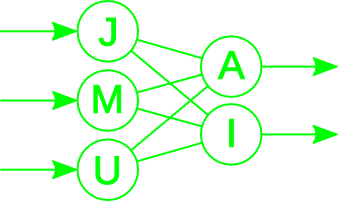Prolog Exercises
-
Consider the following Prolog program.
rich(john). healthy(john). healthy(tim). happy(X) :- rich(X), healthy(X).
These statements encode the facts that John is rich, John and Tim are both healthy, and everyone who is both healthy and rich is also happy. Create a new Prolog file that encodes the following:- John is rich.
- John is healthy.
- Tim is healthy.
- John likes Tim.
- If a person likes someone, then that person likes them back.
- Anyone who is rich, healthy and liked will be happy.
-
The following pair of rules is sufficient for checking membership in a Prolog list:
in(X, [X | T]). in(X, [H | T]) :- in(X, T).
Load these rules, and try them out with a few queries. Then create a new set of rules to that can check to see if an item appears in two consecutive locations in a list. Example queries might look like the following:| ?- in_double(c, [a, b, c, c, d]). true ? yes | ?- in_double(c, [a, b, c, d]). no | ?- in_double(b, [a, X, X, c, d]). X = b ? yes
- If you have time, write and test rules for in2, which should check to see if an item appears at least twice anywhere in a list.
